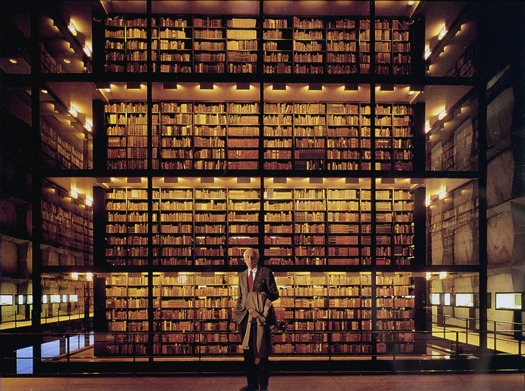
Alvin Eisenman in Beinecke Library at Yale
Alvin Eisenman, a graphic designer who founded Yale’s graduate program in graphic design — the first of its kind in the United States — passed away on September 3, 2013. A heavily attended memorial service was be held on October 26, at the Yale University Art Gallery.
In October 1991, shortly after his retirement from Yale, Eisenman was awarded the AIGA Medal, honoring his teaching and practice. Chris Pullman, a student in Eisenman's class of 1966 — and a member of the faculty ever since — presented the medal with these remarks.
Alvin prefers to describe himself simply as a designer, but most people who know him at all probably would label him as a Teacher. Part of the evidence they would cite is 40 years as Director of the Graduate Program in Graphic Design at Yale until his retirement last January. But Alvin protests this categorization and I think I agree. In my experience, some people teach — that is, you are aware that you are being confronted by someone who is teaching you some specific thing — but other people simply emit. He suffused the program and the place with ideas and information that you didn’t know you needed and didn’t realize you were learning. Within the larger context of the university he provided an environment for learning the relationship of things to other things. But he wasn’t exactly a teacher. In the words of David Pease, Dean of the Art School, he was an enabler.
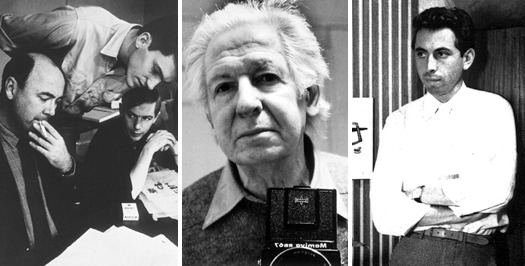
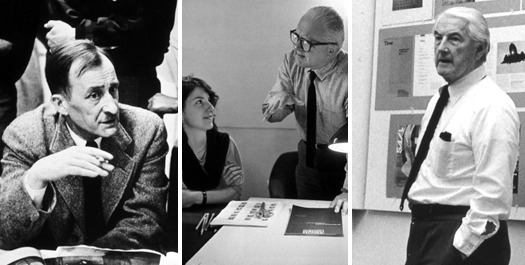
Top row: Norman Ives, Herbert Matter, Alvin Lustig.
Bottom row: Alexey Brodovitch, Paul Rand, Bradbury Thompson
From the very beginning he drew into the program, and gave free rein, to individuals whose professional strength and personal character supplied students an unparalleled and eclectic faculty. The program’s first class supplied its first teacher, Norman Ives. Next came Herbert Matter and, shortly thereafter, Alvin Lustig. “I’m paternal,” says Eisenman, “and Matter was supportive. We needed a New York tough guy. Lusting wasn’t from New York but he filled that role. He asked for a wastebasket up in front of his classroom and threw in student work if it was the wrong size.” Alexey Brodovitch joined the list, and then in 1956 and 1957, Paul Rand and Bradbury Thompson began their association with the school that continues to this day. During this period students were exposed to visiting faculty that included Leo Leoni, Robert Osborn, Lester Beal, and Joseph Low.
Poly Ladamocarsky brought bookbinding into the program and the importance of photography as a related discipline was supported by the appointment of John Hill. Three years later, in 1964, Walker Evans joined the faculty and in 1967 Armin and Dorthea Hofmann began their long and influential association with the program. Along with this core of regulars, students over the past two decades have been influenced by scores of other faculty and visitors, invited by Alvin to participate in the program. These are people who represent almost every stripe: Dieter Rot, Shigeo Fukuda, Dan Friedman, Wolfgang Weingart, Richard Benson, Inge Druckry, Edward Tufte, Philip Burton, Germano Facetti, Mathew Carter. There is a very long list.
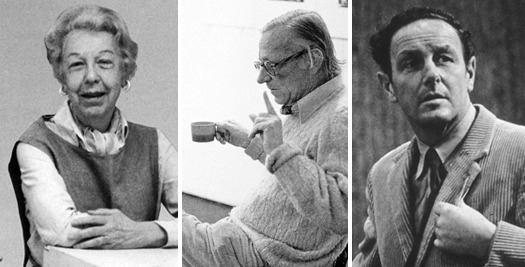
Poly Ladamocarsky, Walker Evans, Armin Hofmann
Alvin seemed to know everybody, but not the way Andy Warhol knew everybody. These were relationships you heard about casually, unexpectedly, by way of example, and they were substantive. His friendships were invaluable to the program, since as students we got to share them, and very handy when it came time to get a job.
He also seemed to know every thing, or at least where to find it out. Being around him reminds me of the old John Cage adage: “If you’re not interested in a thing after a minute, try two minutes.” Alvin found value in everything and there seemed to be nothing you could mention that didn’t set off a long string of observations and personal anecdotes that ended you up in a new place.
At the heart of it, this was Alvin’s gift. His great breadth and amazing depth allowed him to teach by digression. A discourse on the proportion of bricks or the history of the apostrophe or the virility of Eric Gill would come out of nowhere but take you somewhere.
In this respect he was a perfect fit for the university. Scholars and artisans were his friends and his equals. Administrators were his quarry. Presidents and printers were people to learn from and partners in the greater task of communicating ideas and getting better at what you do. In the back of a little book called Yale: A Short History, which Alvin laid out in 1979, is a quote from the inaugural address of President Bart Giamatti, a man he admired and whose tombstone he would later be called on to design. Giamatti wrote:
“The University’s proposal is to teach those who wish to learn, learnfrom those it teaches, foster research and original thought, and, through itsstudents and its faculty, to disseminate that knowledge and to transmit thosevalues of responsible civic and intellectual behavior.”These sentiments also characterize Alvin’s approach to design education. The goals of the admission process appeared to be diversity (both cultural and educational), individual talent and intellectual depth. He looked for students who were exceptional in some way, but it didn’t exactly matter which way. Once accepted, no student was too frightened or too inept or too wacko to give up on, even though a lot of the rest of us on the faculty were tempted. He was determined that everybody should amount to something.
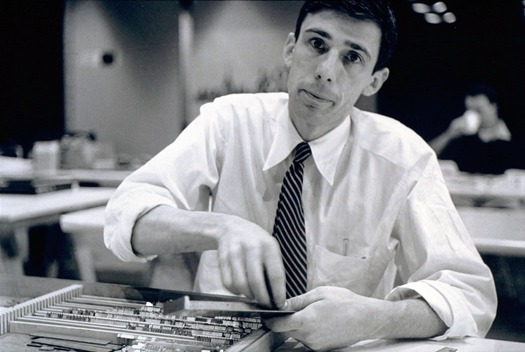
Eisenman setting type in the 1950s.
Alvin brought to Yale qualities observed in one of his own mentors, Ray Nash, with whom he studied at Dartmouth. In an excellent account of Eisenman’s career by Anne Ghroy-Goodman, that appears in the AIGA Yearbook, Nash and Eisenman are compared in this way:
“Nash was a man of caring, depth and character — adjectives studentslater used to describe Eisenman as well. They both lived on farms, workedwith the university presses at their institutions, read broadly and nurturedtheir students.”Alvin also shared the sweetness of his family life with his students. He married his high school sweetheart, Hope Greer, eventually settled in a house with barns in Bethany, Connecticut, and finished raising his family. He mowed the field, raised chickens and went dancing every Sunday night. Each year about this time his home was the scene of a yearly departmental picnic for his extended family of students and faculty.
As the guy who ran the school, he was slippery but effective. He was always available but impossible to get a hold of. At the end of school, in the throes of our Masters Thesis projects, my classmate and future bride Esther so despaired of finishing that she resolved to make an appointment with Alvin to tell him she would not graduate. He managed to miss the first half dozen appointments with creative excuses and by the time she finally got his attention her thesis was basically done.
Although the faculty was made up of practicing professionals, many of them well known for their work in the field, we hardly ever saw anything Alvin made. Not that he didn’t make a lot of things. He has always been prodigiously productive. As design director at McGraw Hill after the war he was responsible for hundreds of books. Invited in 1950 by Carl Purrington Rollins to take over as designer for the Yale Press, Eisenman proceeded to design many complex and beautiful books, frequently dominating the prestigious AIGA Fifty Books of the Year awards. This was also the man who, as a consultant to the Morgan and the European and American Banks, perfected the technique of billing for three half days with one commute to New York, studying Sanskrit or Egyptian hieroglyphs on the train down and back.
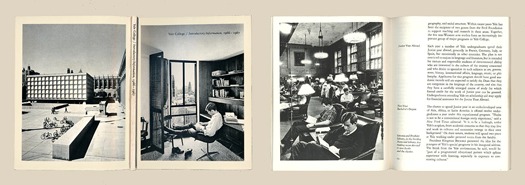
Yale Information booklet 1968
During the mid-sixties, when I was a student at Yale, I noticed a series of simple books and booklets for the university. I don’t think I realized they were his work, but they represented for me and my classmates a kind of tangible standard for typographic design and reproduction that reinforced what we were learning in school. Recalling these effortless-looking books today, it is easier for me to see how compatible they were with the rest of Alvin’s motives as a designer and teacher.
Modest but not dull
Contemporary but not stylish
Typographically refined but not precious
Appropriate, informed, full of content and well made
The thing that distinguished these pieces was not in their fashionableness but in their interest in straightforward clarity and meaningful innovation. His book on Eero Sarrinen published in 1962, aside from being an elegant showcase for the architect’s work, was the Yale Press’ first photocomposed book, the first printed with 300 line screens and the first to be perfect bound using acid free polyvinyl chloride adhesive. In 1967 he designed The Pictorial History of Yale, a dense compilation of images and a major effort to establish an architectural history of the campus using a series of maps which chronicle the growth of Yale over 250 years. The custom, ph-neutral paper which Eisenman cooked up for the project with the Mohawk mill would later be named Mohawk Superfine, still one of the finest arrival book papers available.
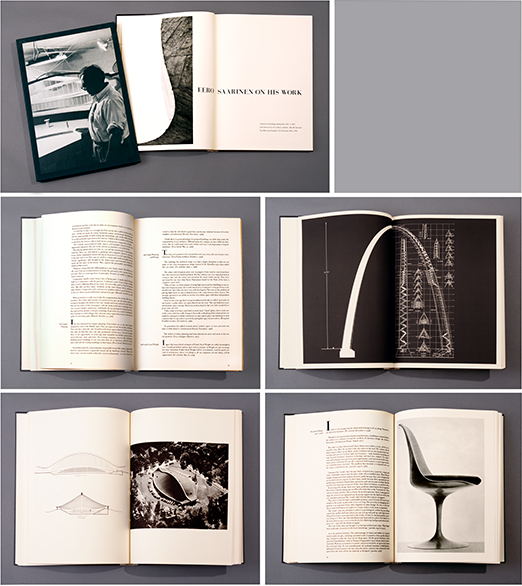
Spreads from Eisenman's book on Eero Sarrinen.
Throughout his life, Alvin’s inquisitiveness made him open not only to people and ideas but also to technological innovation, particularly as it related to the task of visualizing language. Handset type always provided the basis for teaching typography at Yale, but his long association with Mergenthaler Linotype brought a succession of machines into the type shop along side the Vandercook proofing presses. Then in l984 the first Macintosh showed up. Alvin had immediately recognized it as a device that could give students almost instant access to lots of type, cheaply. On a more philosophical level, he saw the Mac as the device which would reunite the author and maker of books. He soon became an advisor to Adobe, and Apple quickly raised him to sainthood.
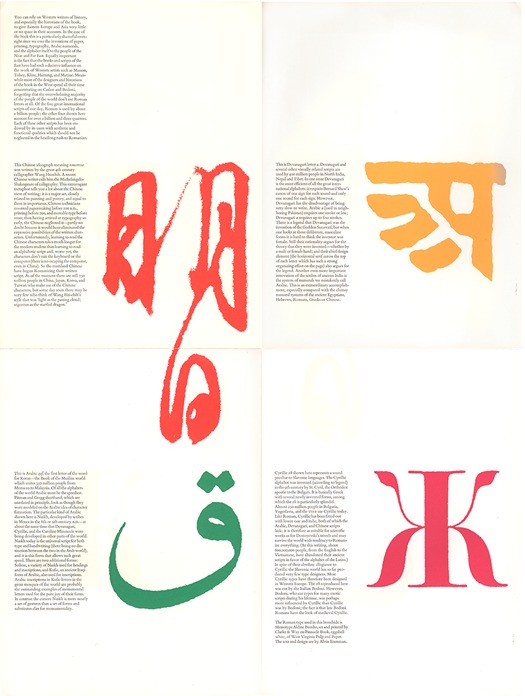
Homage to the Book, Westvaco, 1968. Eisenman's contribution to this portfolio is a broadside featuring four non-Roman writing systems used in the majority of the worlds books.
Yale's program has always encouraged students to bridge the unnatural separation between writing and designing and Alvin is our model for becoming deeply immersed in the content of the work we take on. For as long as I can remember, Alvin has been involved in his own life-long interest in the history of writing systems. His attitude about scholarship on this issue is expressed in his spread for Westvaco’s Art of the Book. He writes:
“You can rely on Western writers of history, and especially the historians of the book, to give Eastern Europe and Asia very little or no space in their accounts. In the case of the book this is a particularly shameful oversight since we owe the inventions of paper, printing, typography, Arabic numerals, and the alphabet itself to the people of the Near and Far East... Meanwhile, most of the designers and historians of the West spend all their time concentrating on Caslon and Bodoni, forgetting that the overwhelming majority of the people of the world don’t use Roman letters at all. ... Each of the other scripts shown here [Chinese, Devanagari, Arabic and Cyrillic] has been endowed by its users with aesthetic and functional qualities which should not be neglected in the headlong rush to Romanize.”It is safe to say they will not be neglected by Eisenman. His work on a major book on the development of communications systems has been accelerated by his retirement from Yale. When it is published, I predict it will be definitive.
But until it is published, the school that Alvin built, with the collaboration of many and the guidance of a great university which saw its good purpose, will likely remain his lasting contribution to Design. In fact, the program helped to redefine this profession. Rob Roy Kelly, an early graduate who for many years headed up the program at Kansas City, put it this way:
“Seldom has a single school or program had such an immediate and overwhelming impact on a profession as did Graphic Design at Yale in the 1950’s and 60’s...For the first time there were viable alternatives to advertising, illustration and commercial art.”Typically, Alvin refused to ever write down a definition of the program, preferring instead to have it be judged on its results. Now over 500 students have graduated from his school, many of whom I wager are in this room. These graduates have spread out through this and many other countries, and have gone about their business, designing and sometimes teaching, each one affecting others with the decisions they make about their life and their professional practice. His work has had a geometric effect in this way.
I can think of few people who have been less in the limelight and yet have had more influence on the course of American Graphic design in the second half of this century than Alvin Eisenman.
This is not a shy person, as you will find out in a few moments, but simply a person unconcerned with fame or being in the front row (unless that’s the place with the best view of what’s going on). For 28 years I have known Alvin variously as a teacher, colleague, mentor and friend, have benefited from his council and have been broadened by his interests. For a long time now I have felt this medal already belonged to Alvin and so I am especially pleased to be able to hand it over to him tonight, officially.
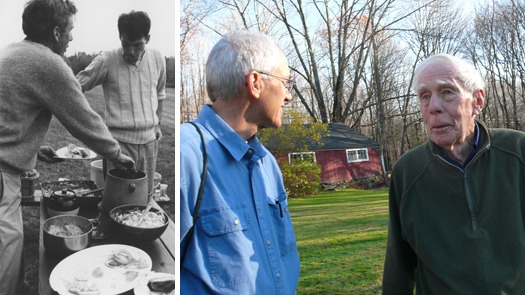
Chris Pullman with Alvin Eisenman. Left: At a picnic at the Eisenman's home in Bethany CT. in the 60's. Right: In 2009.
